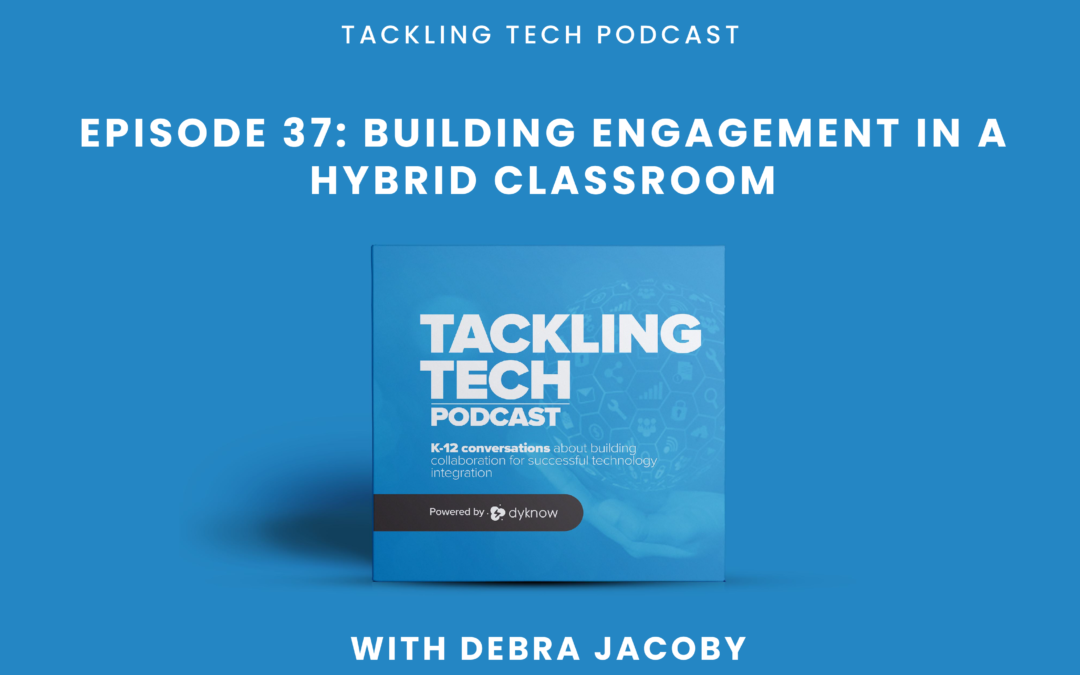On this episode of Tackling Tech Podcast, powered by Dyknow, Brett McGrath speaks with Debra Jacoby, a Computer Science and Instructional Technologist at Pine Crest School in Fort Lauderdale. Debra doles out tips and tricks on keeping both the “zoomies” and “roomies” engaged in a hybrid classroom.
Listen to Episode 37:
Available wherever you listen to podcasts:
Don’t have time to listen to the episode? Here’s a peek at what’s inside…
Debra Jacoby’s role in educational technology
Debra Jacoby is a Computer Science and Instructional Technologist at Pine Crest School in Ft. Lauderdale, FL. She works primarily with elementary students which gives her a unique perspective on technology and education.
Being a Technologist at Pine Crest School is a unique position because they have a strong technology innovation program in which they have two iLabs for K-8 students, another lab for the high school, and a few computer science labs. Debra shared that it does take a strong team to be creative and find the trends in education, so they have their own school-wide conference to promote this creativity and spark innovation for faculty and staff.
Pine Crest School’s learning setup
On Friday, March 13th, when school in-person learning was halted due to COIVD-19, Pine Crest School was able to begin distance learning right on that following Monday. They learned to use the tools and skills they already had, and through that, they were able to understand what worked.
This year they used their LMS (Schoology) to create a course for teachers to take so that they can refresh and understand the big technology tools that they are using and experience them from their students’ perspective.
Working in EdTech, Debra is always in classrooms helping teachers get used to the technology tools that the school has invested in. Distance learning exposed teachers to these different types of tools – it wasn’t until distance learning that teachers realized they needed to use the majority of these technology tools.
This Fall, Pine Crest School decided to go to hybrid learning to accommodate both students in the classroom and students at home. This has consisted of intense training for teachers to warm up to tools and help them understand the school philosophy regarding students being at home and being in school. Debra shared that she gets such a thrill now walking around and seeing all of these tools being used to conduct hybrid learning.
Hybrid learning from a teacher’s perspective
Debra shared that the challenges of hybrid learning are different depending on the age group – high school issues are different from those at the elementary level.
One hybrid learning strategy that’s working across grade levels is having a Google Meet or Zoom meeting run all day long like it’s a regular school day. A challenge at first was making sure students were consistently where they need to be, but Pine Crest has a strict attendance policy, so they don’t have many issues with students joining these calls or keeping their cameras on during class. The Pine Crest technology team also encourages teachers to join their class from multiple devices.
As a part of the technology team and also a teacher, Debra wants other teachers to know that the technology team also feel the pains of hybrid learning, as most of them are also teaching classes and dealing with similar issues.
Tips to make hybrid learning work
In our conversation, Debra shared a few tips for educators who are also working in hybrid environments and how they can make the hybrid environment work better for them.
1. Add variety to where class takes place
Because Debra is in South Florida, she is able to give both teachers and students more flexibility by conducting meetings, classes, and breaks outside. She has been trying to think of ways to give teachers space and time to have some time for themselves, and the outside space they have is perfect for that. She also has been taking students outside with devices so that students can learn effectively outside.
2. Consistently check in with all students
One challenge with hybrid learning is making sure that the students who are at home feel like they are part of the class. Debra suggests checking in with these students consistently by looking at the chat window in Zoom or Google Meet and making sure there are no outstanding questions or comments. It’s also important to also check in with students who are learning in your classroom even though walking around the room to check-in isn’t safe at this time.
3. Collaborate with your team and faculty
Debra’s position is unique because not only is she a technology teacher but she provides Professional Development for teachers, so she reaches out often to see what they’re working on and to collaborate on new tools or integrate new things into their classrooms. She has found a lot of free online tools that her colleagues had been asking for and is able to offer them to her teachers throughout the semester.





